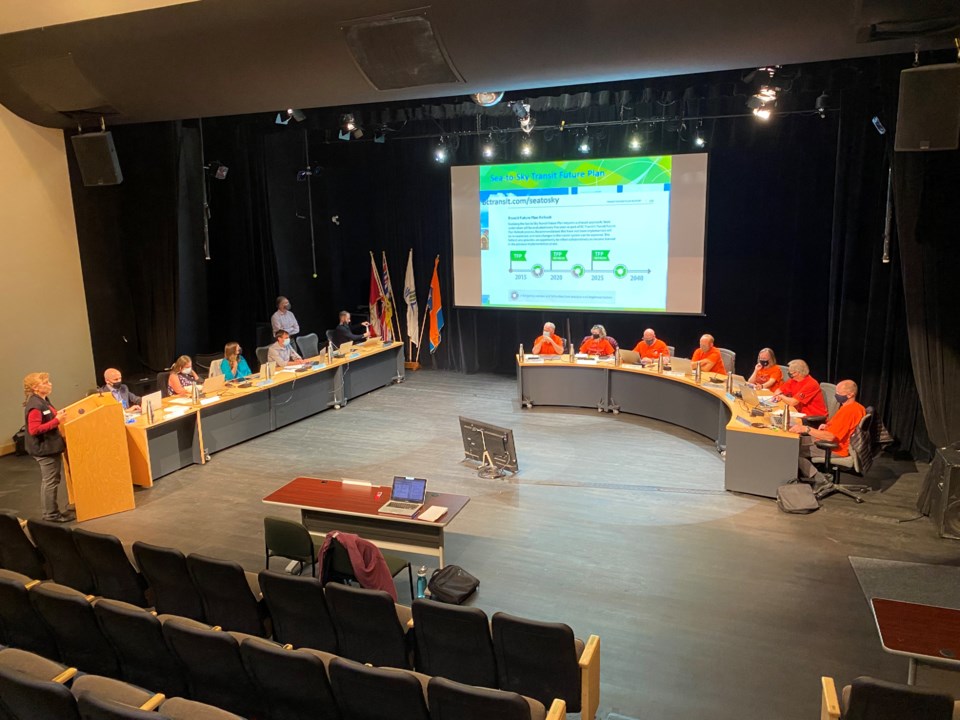While the first months of 2021 showed signs of a financial rebound at the Resort Municipality of Whistler (RMOW), the momentum didn’t carry through the second three months of the year, according to the RMOW’s Q2 financial update.
“Overall operating revenues remain challenged by the COVID-19 environment,” said director of finance Carlee Price in a presentation at the Sept. 21 council meeting.
“We had begun to see a recovery in the first quarter, and that recovery was sidelined to some extent in the second quarter of this fiscal year—part of the reason for that is of course the early closure of Whistler Blackcomb (WB).”
Day-skier parking revenues in Q1 were actually ahead of 2019 levels, but WB’s province-mandated closure on March 29 put the brakes on the momentum, and Q2 parking revenues were down 65 per cent from 2019.
Overall, first-half parking revenues were down 25 per cent from 2019.
“Revenue from transit, parking and [Municipal and Regional District Tax] all declined sharply in the mid quarter, this again is due to the mountain closure as well as some new provincial health orders,” Price said. “Building permits, planning revenue and works and services, by contrast, were all strong, and that carried on right through the second quarter.”
Overall operating revenues were at 76 per cent and divisional operating expenditures 47 per cent of annual budgeted amounts as of June 30, compared to 86 per cent and 48 per cent, respectively, in the prior fiscal year.
Expenditures so far this year reflect changes in the RMOW’s pandemic service delivery, Price noted, pointing to lower spends on events and animation (down 36 per cent from 2020) in the first two quarters of 2021.
That decrease was offset by higher spending in planning (up 22 per cent) and environmental stewardship (up 16 per cent), Price added, due to a growing volume of development and planning work in the community and council’s commitment to focus on climate action, respectively.
“In the CAO office, higher spending was evident in 2021 as compared to 2020 (up 16 per cent), due primarily to communications and economic development,” Price said. “Both of these departments have of course weighty responsibilities in pandemic recovery.”
Spending on IT was up 25 per cent over 2020 (from $1.87 million to $2.05 million), while Meadow Park Sports Centre expenditures also rose 11 per cent (from $3.4 million to $3.9 million) due to increased staffing levels during pandemic operations.
There were 98 projects that recorded “some amount of activity” in the first half of the year, and seven that were at more than 50 per cent of their budgeted spend at the end of June, Price said.
“We did have very low expenditures in the first quarter that accelerated in the second quarter, so total spending at the end of the second quarter was at about 19 per cent of full-year budgeted amounts—this is in line with the last five years’ average,” she said.
The RMOW has amended the budget twice so far in fiscal 2021, with one project added, three amended, and three grant-supported works added, “and then of course we did amend the operating budget slightly in 2021, related to the summer experience, to planning department changes, and for 2022 staff resourcing,” Price said.
“We are at a largest-ever volume in dollars of project-led work at the RMOW, $50.7 million—this excludes a $10-million dollar loan that was made to [the Whistler 2020 Development Corp for resident housing in Cheakamus Crossing].”
While Q3 revenue opportunity looks promising, “we’re sort of approaching the edge of the woods on the pandemic, but not quite there yet,” Price added. “Revenues will remain challenged through the end of this year, and we’re just beginning the process of looking out to 2022 and what might go on there.”
Whistlerites won’t get a sense of what 2022’s tax increases will be until the budget open house in November, but residents can expect increases above the 1.08 per cent requisition seen in 2021.
While the RMOW was saved from having to “dip into the rainy day fund” last year thanks to a large grant from the federal and provincial governments, “no such cavalry can fairly be expected to arrive this year,” Price said. “So depending on how the remainder of the year goes, we may dip into the operating reserve to some extent—it could be up to $2 million—but until those final numbers for the year are in we can’t say with certainty.”
Asked by Mayor Jack Crompton if there’s anything that concerns her, Price pointed to the shape of the pandemic recovery.
“The visibility we used to have ... is to some extent impaired, so not knowing what 2022 will hold, or even what the fourth quarter will hold, is concerning,” she said.




